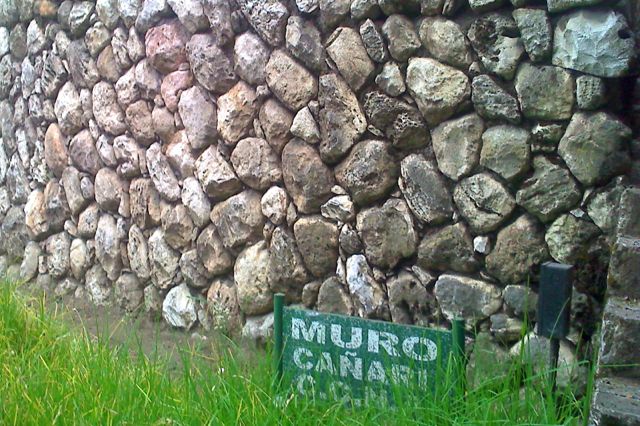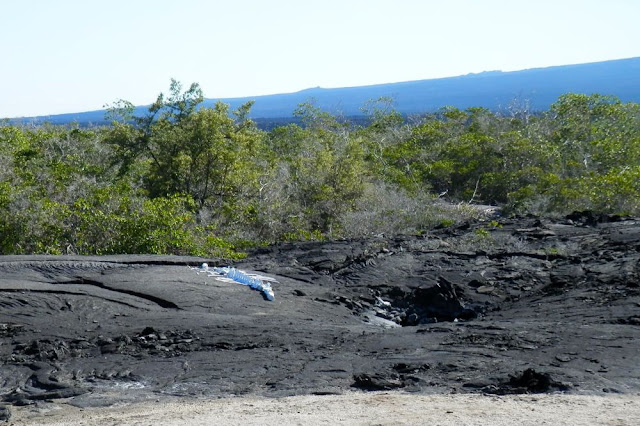Birds Gotta Swim,
Fish Gotta Fly
Truth in Advertising:
there are not pictures of flying fish in this segment. Capturing flying fish on a digital camera is
tough, well beyond my abilities. We did,
however see them on several occasions.
It turns out they’re pretty common.
And why they fly is still
speculative- the two leading hypotheses are predator escape and energetic
savings, hard as that may be to believe.
But the real topic
for today is flightless birds. There are
two species of flightless birds in Galápagos:
the Galapagos Penguin (Spheniscus mendiculus) and the Flightless Cormorant (Phalacrocorax harrisi). Donna and I were fortunate enough to see both
on our trip.
 |
| A Penguin and a Sea Lion facing off. From Santiago Island in 2010. |
The Penguin is one of
the most popular residents of the Galapagos- it is, after all, pretty startling
to see penguins on the equator. The
Galapagos Penguin is in fact the only one that lives north of the equator (though we only saw them when south of the
equator). There are about 5000 of them,
which is a pretty small number, spread out through the central and western
islands.
 |
| They're even in church windows |
The most probable
place for people to see them is around Bartolome, off Santiago Island- there is
a resident colony there, and I’ve seen them there pretty much every time I’ve
had the chance. But they can also be seen
near Floreana (I know because of this photo from 2010), around much of
Santiago, and Isabela.
 |
| Penguin off Floreana. Also from 2010. |
And when you go
around Isabela, to the West, toward Fernandina- that’s when the flightless bird part takes off (sorry)!
The western side of
Isabela is the “cold” side, in terms of the water- the Cromwell current pushes
in from the West, and brings in cold, cold water. This water may be less-than-fun to swim in
for normal people, but it brings nutrients that form the base of a pretty
spectacular food web, and results in these waters being a wonderful place to
see marine life.
This trip was the
first time I’d had the chance to see this part of the Galapagos- for the first
week and a bit, we were going to places I’d been before, or at least very
similar. This area was what I had been
waiting for (see earlier post on Fernandina).
Our first stop after
heading past Puerto Villamil (the town on Isabela), was Elizabeth Bay. The National Park is pretty strict about what
you can do where- some places you can hike, some you can snorkel, some you can
only ride in the pangas and look.
Elizabeth bay was this latter type- but was such a great place for seeing the birds (and also sea turtles),
that it was totally worth it. There were
many, many seabirds there, including the two flightless stars. The photo at the top of this entry gives
you the idea. Close examination of the
shot will reveal at least 5 species of birds- blue-footed boobies, brown pelicans,
frigatebirds (probably magnificent frigatebirds), penguins and cormorants. After spending a lot of time looking at this
small rock full of birds, we cruised around to see what other opportunities
would present themselves.
I didn’t notice until
later that one of the first penguins we saw, on the rock, was bloody- I do not
know why.
 |
| 2 Penguins and a couple of Blue-footed Boobies |
The penguins were
good at finding any small bit of rock to rest on when they wanted a break from
swimming
Not that they were
slouches at swimming (more in a moment)
The surreality of the
situation, equatorial penguins, was driven home by seeing them among the red
mangroves that helped define the bay.
Here's a little video of a penguin swimming, off Santiago:
Enough about the penguins for now. The other flightless bird, and the one I’d
been really anticipating seeing, was
the flightless cormorant, and to see them, you have to do west of isabela.
This is the only place these
birds are found, in the world. Recall, I
mentioned them on Fernandina:
Before we see them, a word about cormorants in general.
Below is a photo from Alaska this summer. There are two species shown here- the Pelagic
Cormorant (Phalacrocorax
pelagicus) and the Red-Faced
Cormorant (Phalacrocorax urile).
The thing that’s interesting about
cormorants (okay, one thing) is that, although they are seabirds, their
feathers are not completely waterproof.
A Booby, or a Pelican, for example, can spend all day diving into the
water, then taking off from the surface and diving again and again (pics
later). But cormorants, and their
somewhat close relative the anhinga (Anhinga anhinga), get waterlogged (the less waterproof
feathers do in fact confer some advantage- they decrease buoyancy, allowing the
bird to stay under water more easily).
As a result,
cormorants and anhingas, after spending time in the water, need to spend time
sunning so that their wings dry enough for flight. Here are a couple examples- the first is a
cormorant from Alaska, and the second an anhinga, from Florida this past
November.
The anhinga at least
is also probably warming up a bit. Now,
remember this part- they sun themselves
to dry their wings so that they can fly.
Also look at the wings.- nice, hmm?
Now, the Flightless
cormorant of the Galapagos. Note the
first word- flightless. These birds have lost the ability to fly- a
reasonably common evolutionary change in birds when predators are absent, as on
islands. They make their living by
swimming, both at the surface and diving under water (I couldn’t get a pic of
this- they’re really fast).
They’re very
picturesque, and have long thin necks.
They also have a surprising deep moo-ing voice.
But the last of the
above picture begins to show the weird, wild thing. Check the cormorant’s pose. Look familiar?
That’s right, this
cormorant is holding out its wings to dry them.
First, check out the wings- not as impressive as his/her Alaskan
relatives are they? This is typical in
flightless birds- the old “use it or lose it” concept. If maintaining wings, with their attendant
muscles, bone, nerves, etc, costs energy (and it does), and they’re not being
used, the individuals who have cheaper (less developed) wings have an advantage
in energy savings. And if the under-development
is genetic, they can pass this trait on to their offspring, who also have the
advantage. Over generations, the wings
of the flightless population atrophy to the point seen in the pictures
below.
But the birds still go through the motions of drying
their wings, despite the fact that they’re never going to fly! (I admit, they probably also do warm up a
little, but these atrophied wings are also a lot less effective as solar panels
than the ones in the Alaska cormorants and the anhinga).
I love that- a
near-vestigial organ (the wings), and what appears to be a vestigial behavior
as well.
 |
| The end? |


















































